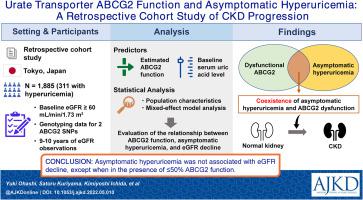American Journal of Kidney Diseases ( IF 9.4 ) Pub Date : 2022-07-08 , DOI: 10.1053/j.ajkd.2022.05.010 Yuki Ohashi 1 , Satoru Kuriyama 2 , Tomoko Nakano 3 , Mai Sekine 1 , Yu Toyoda 4 , Akiyoshi Nakayama 5 , Tappei Takada 6 , Yusuke Kawamura 4 , Takahiro Nakamura 7 , Hirotaka Matsuo 4 , Takashi Yokoo 8 , Kimiyoshi Ichida 9

|
Rationale & Objective
Treatment of asymptomatic hyperuricemia is not commonly implemented. However, it is unclear whether urate deposition that begins during asymptomatic hyperuricemia can induce nephropathy. Dysfunction of ATP-binding cassette subfamily G member 2 (ABCG2), a urate efflux transporter, leads to elevated serum uric acid concentration (SUA). We investigated the association between asymptomatic hyperuricemia and decreased estimated glomerular filtration rate (eGFR), and the impact of ABCG2 on this relationship.
Study Design
Retrospective cohort study.
Setting & Participants
1,885 Japanese adults undergoing routine health care follow-up between 2007 and 2017 who had eGFR ≥60 mL/min/1.73 m2, of which 311 had asymptomatic hyperuricemia (SUA >7.0 mg/dL). Study participants were classified into 3 categories of estimated ABCG2 function (full, 75%, and ≤50% function).
Predictors
Baseline SUA and estimated ABCG2 function.
Outcome
Change in eGFR over time.
Analytical Approach
Linear mixed-effect models were used to analyze the relationship between asymptomatic hyperuricemia, ABCG2 function, and eGFR decline.
Results
Asymptomatic hyperuricemia was negligibly associated with eGFR decline overall. However, among those with eGFR 60-89 mL/min/1.73 m2 and ≤50% ABCG2 function, eGFR decline was associated with asymptomatic hyperuricemia (P = 0.03). ABCG2 was not associated with eGFR reductions when the SUA was <6.0 mg/dL. Among participants with SUA ≥6.0 mg/dL and eGFR 60-89 mL/min/1.73 m2, ≤50% ABCG2 function was associated with approximately 1.2-fold faster eGFR decline compared with fully functional ABCG2 (P = 0.02). Among the participants with SUA ≥6.0 mg/dL and eGFR 60-89 mL/min/1.73 m2, the adjusted eGFR slopes (given as mean ± standard error of the mean, in mL/min/1.73 m2 per year) were −0.946 ± 0.049, −1.040 ± 0.046, and −1.148 ± 0.069 for full, 75%, and ≤50% ABCG2 function, respectively.
Limitations
Lack of measurement of urinary urate and uremic toxins that are known to be transported by ABCG2, and no independent validation cohort.
Conclusions
Asymptomatic hyperuricemia was not associated with eGFR decline, except when in the presence of ≤50% ABCG2 function.
Plain-Language Summary
The urate transporter ABCG2 is a protein that regulates serum urate concentrations; when dysfunctional, it can lead to elevated serum concentrations of this compound (ie, hyperuricemia). Although persistent hyperuricemia induces gout and kidney injury, the effects on organs during the asymptomatic phase have yet to be established. Therefore, to clarify the relationship between ABCG2, asymptomatic hyperuricemia, and kidney function, we conducted a retrospective cohort study of 1,885 healthy participants, including 311 participants with asymptomatic hyperuricemia. We found that the coexistence of asymptomatic hyperuricemia and severe ABCG2 dysfunction was associated with the age-dependent decline in kidney function. We concluded that asymptomatic hyperuricemia represents a risk factor for chronic kidney disease, at least in individuals with highly dysfunctional ABCG2. This new finding highlights the potential importance of ABCG2 in the pathogenesis of hyperuricemia-induced kidney injury.
中文翻译:

尿酸盐转运体 ABCG2 功能和无症状高尿酸血症:CKD 进展的回顾性队列研究
理由和目标
无症状高尿酸血症的治疗并不普遍。然而,尚不清楚无症状高尿酸血症期间开始的尿酸盐沉积是否会诱发肾病。ATP 结合盒亚家族 G 成员 2 (ABCG2)(一种尿酸盐外排转运蛋白)的功能障碍导致血清尿酸浓度 (SUA) 升高。我们研究了无症状高尿酸血症与估计肾小球滤过率 (eGFR) 降低之间的关联,以及 ABCG2 对这种关系的影响。
学习规划
回顾性队列研究。
设置和参与者
1,885 名在 2007 年至 2017 年间接受常规医疗保健随访且 eGFR ≥60 mL/min/1.73 m 2的日本成年人,其中 311 名患有无症状高尿酸血症 (SUA >7.0 mg/dL)。研究参与者被分为 3 类估计的 ABCG2 功能(完整、75% 和≤50% 功能)。
预测器
基线 SUA 和估计的 ABCG2 功能。
结果
eGFR 随时间的变化。
分析方法
使用线性混合效应模型分析无症状高尿酸血症、ABCG2 功能和 eGFR 下降之间的关系。
结果
无症状的高尿酸血症与总体 eGFR 下降的相关性可以忽略不计。然而,在 eGFR 60-89 mL/min/1.73 m 2且 ABCG2 功能≤50%的患者中,eGFR 下降与无症状高尿酸血症相关(P = 0.03)。当 SUA <6.0 mg/dL 时,ABCG2 与 eGFR 降低无关。在 SUA ≥ 6.0 mg/dL 和 eGFR 60-89 mL/min/1.73 m 2的参与者中,与功能完备的 ABCG2 相比,≤50% ABCG2 功能与 eGFR 下降快约 1.2 倍相关(P = 0.02)。在 SUA ≥ 6.0 mg/dL 和 eGFR 60-89 mL/min/1.73 m 2的参与者中,调整后的 eGFR 斜率(给出平均值±平均值的标准误差,单位为 mL/min/1.73 m 2每年)分别为 −0.946 ± 0.049、−1.040 ± 0.046 和 −1.148 ± 0.069,用于完整、75% 和 ≤50% ABCG2 功能。
限制
缺乏对已知由 ABCG2 转运的尿酸和尿毒症毒素的测量,也没有独立的验证队列。
结论
无症状高尿酸血症与 eGFR 下降无关,除非 ABCG2 功能≤50%。
通俗易懂的摘要
尿酸盐转运蛋白 ABCG2 是一种调节血清尿酸盐浓度的蛋白质;当功能失调时,它会导致该化合物的血清浓度升高(即高尿酸血症)。虽然持续的高尿酸血症会诱发痛风和肾脏损伤,但在无症状阶段对器官的影响尚未确定。因此,为了阐明 ABCG2、无症状高尿酸血症和肾功能之间的关系,我们对 1,885 名健康参与者(包括 311 名无症状高尿酸血症参与者)进行了一项回顾性队列研究。我们发现无症状高尿酸血症和严重 ABCG2 功能障碍的共存与肾功能的年龄依赖性下降有关。我们的结论是,无症状的高尿酸血症是一个危险因素慢性肾病,至少在 ABCG2 高度功能失调的个体中。这一新发现强调了 ABCG2 在高尿酸血症引起的肾损伤发病机制中的潜在重要性。











































 京公网安备 11010802027423号
京公网安备 11010802027423号